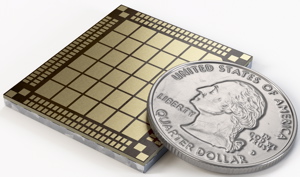Prediction for 2010-2011: The market for broadband-connected point-and-shoot cameras will grow
Last year at CES, I spoke to someone who very accurately predicted that we'd be seeing lots more e-readers and 3G connected netbooks at this year's CES.
At the time, I dismissed it because his company wasn't really unveiling anything, and I was too hung up on covering all the breaking announcements. Later in 2009, I spoke to him again, and he reminded me about the e-reader market blowing up. When we spoke then, the Kindle 2 had launched, and there were probably three or four big names promising new products, but that was it.
It turns out, his company was supplying the wireless modules for Sony's first Reader with 3G connectivity, and he knew that there were going to be a lot of e-readers because of the demand for his company's products. The company, of course, is Ericsson, and the man is Mats Norin, president of Wireless Modules.
Last September, Ericsson launched a mobile broadband chip even smaller than the ones used in the e-readers and netbooks on the CES 2010 show floor, and among the potential applications of the module, Norin said, "It could fit into new types of devices we can't even imagine yet, it may be point and shoot cameras..."
So this time around, I made sure to schedule a meeting with him to see if he was giving me signs again. Are we going to head into CES 2011 and find all the latest point and shoot cameras with HSPA 7.2? After all, Ericsson's technology has thus far been well ahead of the device makers' business models.

"This year, it's more about development of business models," Norin said. "And you need to have creative operators, creative device manufacturers, and so on. The e-book readers are a good example of creative business models."
"Imagine if you had your digital camera, and you could just upload your pictures to the cloud, where [the camera maker] does all the backup for you, it would be like a reverse e-book store, where your device comes with a service to upload things instead of download," he continued. "The technology is there; you could build this very chip into a digital camera and it wouldn't be that big of an effort."
"But then you have to solve the business model...how do you pay for it? The nice thing about the business model for the e-reader is that people still go to the bookstore and buy books. The new technology and the new business model are built upon an existing behavior, and that's part of what makes them successful."
"Take the digital camera as an example," he said. "Before we had digital cameras, we used to pay to have our photos developed in a lab. Perhaps you could pay for your 'film' to be uploaded in the cloud, then you know exactly what you're paying for, and I think that's one of the secrets of of a device's success. You must, as a consumer, know what your money gets you."
"I strongly believe," Norin declared, "that this year you will see more types of smaller connected devices, and more dedicated types of devices, because the industry both here in the U.S. and in Taiwan is very creative, so they will try new types of applications and devices on the market this year...a lot of them will probably fail, but we'll see next year."
